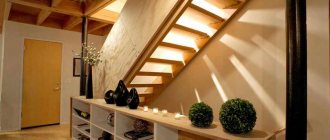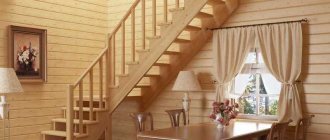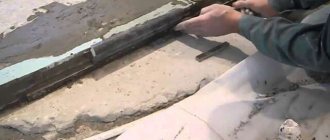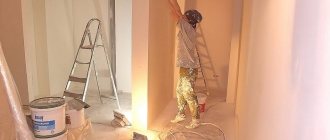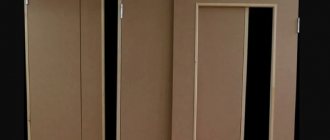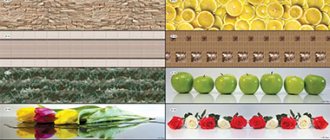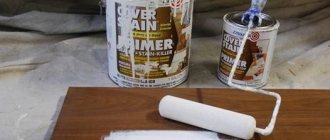Wooden interfloor staircases are common in private housing construction. Wood is an easy-to-work material from which you can make a durable and beautiful structure, but it requires special care.
To protect wood from rotting, drying out, and premature wear, it is varnished or painted. Moreover, for the steps you should choose especially durable paints that can withstand daily loads.
How to paint wooden stairs: painting method
There are several options for how to paint wooden stairs. The two main ones are coloring and tinting. When painting a staircase, the wood texture – that is, its pattern – is hidden. This is true if the staircase is made of wood whose design is not very beautiful, for example, pine or birch. Toning is giving wood a different shade while maintaining the texture of the material. It is better to use for stairs made from expensive elite types of wood - ash, beech, oak. For example, oak wood is incredibly beautiful - such a pattern should be emphasized with a more saturated shade, and not hidden under a thick layer of paint.
There are no exact rules on how to paint a wooden staircase, that is, in which cases it is necessary to tint and in which cases the staircase should be painted. When deciding how to finish a wooden staircase - paint or impregnation, be guided by your own preferences. Both methods allow you to give the structure an original appearance.
Problems
Is wood any different from, say, metal in terms of applying paint and varnish coatings? Does pine stand out in any way compared to other types of wood?
- Unlike metal, wood is hygroscopic. Its surface absorbs paints and solvents just as well as water.
- Moistening or applying a layer of paint means the pile is raised: the wood fibers change their orientation, and the surface becomes rough.
- The wood texture itself is quite beautiful and can be used as a decorative element. Of course, in this case the final coating should be transparent or translucent.
- Pine is distinguished by a large amount of resin that impregnates the material. Not all paint will adhere to the tarred area; what is equally important is that the resin content is uneven. As a result, the coating itself may become uneven.
Let us clarify: resinity is a property not only of pine. All conifers have it to one degree or another.
Choosing what to cover the wooden steps of the stairs with
When choosing paints and varnishes for stairs, it is better to give preference to those paints that are specifically designed for wood - alkyd paints are the best. Among the brands we can mention the well-known Tikkurila or Betolux. Any impregnation will do; the most common are regular stain or Pinotex.
From all the variety of varnishes, it is better to choose polyurethane parquet varnishes - matte or semi-matte. Polyurethane varnish is quite expensive compared to other types of varnish for stairs, but provides maximum protection against impact and deformation and is the most durable.
Finally, another type of coating that is used for stairs is special oils. They simultaneously color the wood, protect it from rotting and moisture, and form a durable surface layer. We'll talk about how to paint wooden stairs with oils below.
Choice of paint and varnish
How to paint a pine staircase? Or, if your choice is a varnish coating, what to varnish it with?
It is worth separating the working surface of the steps and all other elements of the staircase: they have completely different modes of operation. The steps are subject to severe wear and tear; In addition, pine, as we remember, is a species with low wood density. Stilettos or hard heels may well leave marks on it if the strength of the protective layer is low.
On the other hand, handrails and accessories for stairs (bowstrings, balusters) and the back side of the steps are practically not exposed to loads. Any coating will serve mostly decorative functions - of course, in addition to protection from rotting and moisture.
Hence the choice of materials:
- For the working surface of the steps, alkyd-based floor enamels are used - domestic PF-266 and imported analogues. Brand preferences are deeply subjective, so we will not name specific names in order to avoid accusations of hidden advertising.
- The best varnish for pine stairs (more precisely, for the surface of the steps) is polyurethane parquet . Its price is quite high; but it forms an extremely durable and wear-resistant surface.
Advice: it is better to choose matte or semi-matte varnish rather than glossy. It shows less visible signs of wear, which will inevitably appear in the center of the steps, even after a long time.
How to paint a wooden staircase correctly at home
Before covering a wooden staircase with paint, it must be thoroughly plastered, all debris and dust removed, and then coated with a wood primer.
1. Before applying paint and varnish, the stairs are puttied and cleaned with a grinding machine. You can also use regular sandpaper. After 24 hours we repeat the treatment.
2. The next stage is primer. It is done in two layers, also with a break of 24 hours.
3. Cover the stairs with paint using a roller or brush (a brush is more convenient) in 2-3 layers (each subsequent one is applied only after the previous one has dried). You can also use a spray gun, but it must be designed to work with viscous paints.
4. The final step is to apply clear varnish.
When tinting the stairs at stage three, instead of paint, impregnation is applied, which gives the wood a richer and deeper color.
For the treatment of stairs, specific compositions are also used - special oils, priming, tinting and finishing. In this case, there is no need to varnish the stairs - its role will be played by a solid finishing oil that can create a good protective coating on the surface of the wood. In addition, tinting oil is available in a very wide range of colors, which allows you to choose almost any color for the stairs. There is no need to tell you how to paint wooden stairs with special oils - just apply them with a brush in several layers.
Oils for stairs can be purchased not only individually, but also as a set, which significantly reduces the cost of painting stairs.
Comments: 7
Tatiana
- Clear the work area - remove anything unnecessary from the stairs, such as carpets or runners. Cover all surfaces that you do not plan to paint with newspaper or cloth, and secure them where necessary with masking tape.
- If nails or track holders protrude from the stairs, hammer them 2-3 mm into the wooden surface with a hammer and cover the top with wood putty to ensure a smooth surface.
- If you are painting over old varnish, lightly sand the wood surfaces with fine sandpaper to help the new paint adhere better. If the old coating is in poor condition, wash it off with a special paint removal solution.
- Vacuum the stairs and railings and then wipe with a damp cloth to remove all dust and dirt. Wipe dry and allow time to dry thoroughly.
- It's time to prime! A high-quality primer will ensure good adhesion of the paint to the coating and its stability. Use a professional primer on all exposed and filled wood surfaces.
- Once the primer is completely dry, you can begin painting. Start painting from the top of the stairs and try to thoroughly paint the wood grain. After 6-8 hours the next layer can be applied.
- If you are painting the stairs and railings different colors, paint them at different times and allow plenty of time to dry. Use masking tape to ensure the boundaries between colors are clear and even.
- When the paint has dried, you can lay down the carpets and runners again, or you can leave the stairs as they are - in a minimalist style and a new color.
- These are general recommendations, and in order to decide in your case, you need to know: you have a new staircase or a staircase that requires updating, whether you need stripping, putty, sanding and in what volumes, the requirement for surface coverage, the frequency of using the stairs. Preferably a photo.
- Likes: 1
- Save
Bureau9
Check out Belinka's products. https://www.belinka.ru/ Partners - adequate in work and consultation. Call them and they will give you comprehensive information. Good luck!
- Like
- Save
How much does it cost to paint a staircase yourself?
Let's roughly calculate how much it will cost to paint the stairs yourself. When choosing how to cover a wooden staircase, be guided, among other things, by the cost of the composition. There is no need to take, for example, expensive yacht varnishes - even for oak stairs.
If we take a certain market average cost of paints and varnishes, then the costs will look something like this (for a standard flight of stairs):
- 1 liter – 1,000 rub.;
- 2 liters of impregnation – 2,000 rubles;
- 6-7 liters of parquet varnish – 14,000 rub.
Thus, painting a wooden staircase yourself will cost you 17,000 rubles. In general, about the same amount (a little more or a little less depending on the model of the staircase) is the cost of factory painting of the staircase. For example, painting an economical staircase made of pine FAVORIT LMP-11 by the manufacturer will cost 14,900 rubles.
Related discussions
Need advice on hallway layout
Need advice on finishing the corridor and stairs to the 2nd floor
Need advice on the color of porcelain tiles for the stairs
loba_boba
The staircase is completely new, recently installed. Pine, two-march classic.
I would like the result to be something like the one in the photo below. And the main question is about the painting sequence. First the steps are dark, then the risers are white? or vice versa?
- Like
- Save
How to paint wooden stairs: painting method
There are several options for how to paint wooden stairs. The two main ones are coloring and tinting. When painting a staircase, the wood texture – that is, its pattern – is hidden. This is true if the staircase is made of wood whose design is not very beautiful, for example, pine or birch. Toning is giving wood a different shade while maintaining the texture of the material. It is better to use for stairs made from expensive elite types of wood - ash, beech, oak. For example, oak wood is incredibly beautiful - such a pattern should be emphasized with a more saturated shade, and not hidden under a thick layer of paint.
There are no exact rules on how to paint a wooden staircase, that is, in which cases it is necessary to tint and in which cases the staircase should be painted. When deciding how to finish a wooden staircase - paint or impregnation, be guided by your own preferences. Both methods allow you to give the structure an original appearance.
Choosing what to cover the wooden steps of the stairs with
When choosing paints and varnishes for stairs, it is better to give preference to those paints that are specifically designed for wood - alkyd paints are the best. Among the brands we can mention the well-known Tikkurila or Betolux. Any impregnation will do; the most common are regular stain or Pinotex.
From all the variety of varnishes, it is better to choose polyurethane parquet varnishes - matte or semi-matte. Polyurethane varnish is quite expensive compared to other types of varnish for stairs, but provides maximum protection against impact and deformation and is the most durable.
Finally, another type of coating that is used for stairs is special oils. They simultaneously color the wood, protect it from rotting and moisture, and form a durable surface layer. We'll talk about how to paint wooden stairs with oils below.
How to paint a wooden staircase correctly at home
Before covering a wooden staircase with paint, it must be thoroughly plastered, all debris and dust removed, and then coated with a wood primer.
1. Before applying paint and varnish, the stairs are puttied and cleaned with a grinding machine. You can also use regular sandpaper. After 24 hours we repeat the treatment.
2. The next stage is primer. It is done in two layers, also with a break of 24 hours.
3. Cover the stairs with paint using a roller or brush (a brush is more convenient) in 2-3 layers (each subsequent one is applied only after the previous one has dried). You can also use a spray gun, but it must be designed to work with viscous paints.
4. The final step is to apply clear varnish.
When tinting the stairs at stage three, instead of paint, impregnation is applied, which gives the wood a richer and deeper color.
For the treatment of stairs, specific compositions are also used - special oils, priming, tinting and finishing. In this case, there is no need to varnish the stairs - its role will be played by a solid finishing oil that can create a good protective coating on the surface of the wood. In addition, tinting oil is available in a very wide range of colors, which allows you to choose almost any color for the stairs. There is no need to tell you how to paint wooden stairs with special oils - just apply them with a brush in several layers.
Technology
So, we have decided how to cover a pine staircase. You can start working. Where to begin?
Resin
One of the typical problems of pine has already been mentioned: resin. The resin content of the fibers and, most importantly, the resin pockets. How to get rid of this scourge?
Acetone or turpentine can help. Both solvents are excellent at removing traces of resin and dissolving resin accumulations in pockets. For cleaning use ordinary rags.
Turpentine dissolves all natural resins.
putty
The optimal choice in our case is acrylic wood putty. Irregularities, cavities from knots and resin will have to be puttied 2-3 times with intermediate sanding: the putty shrinks when it dries.
If painting is to be done, the color of the putty does not matter; but when varnishing it is better to match it to the tone of the wood. The exception is the case when the final coating is dark tinted varnish: white patches on a light background under its layer will not be noticeable.
Grinding
A sander can be used on the planes, but the balusters, the surface of the steps between them and the handrails will have to be sanded by hand. For sanding, you will have to stock up on several types of sandpaper with different grits: trying to jump from 60 to 120 grit will only be a waste of time. You shouldn’t treat the stairs with zero polish: save it for interlayer sanding of the paintwork.
How much does it cost to paint a staircase yourself?
Let's roughly calculate how much it will cost to paint the stairs yourself. When choosing how to cover a wooden staircase, be guided, among other things, by the cost of the composition. There is no need to take, for example, expensive yacht varnishes - even for oak stairs.
If we take a certain market average cost of paints and varnishes, then the costs will look something like this (for a standard flight of stairs):
- 1 liter – 1,000 rub.;
- 2 liters of impregnation – 2,000 rubles;
- 6-7 liters of parquet varnish – 14,000 rub.
Thus, painting a wooden staircase yourself will cost you 17,000 rubles. In general, about the same amount (a little more or a little less depending on the model of the staircase) is the cost of factory painting of the staircase. For example, painting an economical staircase made of pine FAVORIT LMP-11 by the manufacturer will cost 14,900 rubles.
In ready-made staircase stores you can also buy pre-treated staircases - coated with oils and completely ready for installation. When purchasing such models, you do not have to spend additional money. Here is one of the stairs from our own production - this model is available in two different colors.
Factory painting and varnishing of stairs has another advantage over doing it yourself. The manufacturer knows all the characteristics of wood and selects paint and varnish materials accordingly, using only professional varnishes and oils. It is very difficult to choose from all the variety of paint and varnish compositions on the market exactly those that will ideally fit on your wooden staircase. And it is almost impossible to achieve a coating quality comparable to the factory one.
Painting balusters to look like marble video
Balusters and balusters and carved pillars of the Roman baluster type as an architectural form were common in the architecture of the ancient Greeks and Romans - both small balusters and large massive columns were an obligatory element of the front part of the building. Today, architectural standards do not require the mandatory presence of this kind of decoration, but balusters are often found as a functional element, since it is still impossible to make a porch, staircase or balcony without such elements. Vertical railings for stairs, terraces and balconies not only protect a person from falling, but also provide the necessary support when descending and ascending. In houses where elderly people and small children live, such support is necessary. Balusters are functional regardless of their shape. Based on their shape, railing posts can be divided into three types: 1. Balusters in the form of bodies of revolution. This form can be either a regular cylinder or a flowerpot of any shape. Such models are made on a lathe, each column looks like a finished element. This form is the most common. 2. Carved balusters, pilasters, carved for stairs
are made from boards and are mainly used on technical stairs, for example, to the attic. To decorate such models, figured through holes are often used. 3. Sculptural balusters have a complex, free-form shape and are made by hand or using a multi-axis machine. The materials for balusters are concrete, stone, polymer materials and, of course, wood.
Painting balusters to look like marble video
Wood balusters are practical, relatively inexpensive and durable under certain operating conditions. Wood is a very technologically advanced material, and therefore allows you to cut products of a wide variety of shapes, so that a carved support for a railing with a beautiful silhouette performs an aesthetic function without sacrificing functionality. Wooden stairs with balusters can be an effective addition to the interior.
Natural wood has a beautiful structural surface that looks great not only in a classic, but also in any other interior, and at the same time is a fairly durable material that can withstand serious impact loads, which means it can protect a person from falling from a height.
Painting balusters to look like marble video
Cooperation with the manufacturer is always more profitable. First, coat the balusters with water-based varnish
allows you to avoid paying for the services of an intermediary, which means purchasing the necessary building materials is 10-15% cheaper. If we are talking about a large batch, then the amount saved in monetary terms can be very significant.
If the buyer wants to buy flat balusters from the manufacturer, according to an individual project, then he should contact our company directly. The production area contains the necessary turning equipment, which allows us to manufacture products according to the provided technical documentation. By contacting us, you will receive the ordered products in guaranteed high quality and on time.
We work with all regions of Russia, our balusters can be bought in such large cities as Minsk, Nizhny Novgorod, Tyumen, Novosibirsk, Yekaterinburg, Krasnoyarsk, St. Petersburg (St. Petersburg), Chelyabinsk, Perm, Ufa, Moscow and other cities, and therefore worth seriously consider the possibility of cooperation with our company. We are ready to offer our clients the most favorable terms of cooperation, and therefore it is worth placing an order for the production of wooden balusters with us. The quality of our work has already been appreciated by the majority of our clients, who have become regular customers.
Our company offers to buy components for stairs wholesale at competitive prices, as well as buy handrails for stairs from the manufacturer.
Why paint a wooden porch?
A number of negative factors affect the condition of the porch:
- Precipitation. Under their influence, the wood swells and collapses. This reduces the life of the product (be it a staircase, a veranda, a wooden bench or a country toilet).
- Ultraviolet radiation. The sun's rays discolor the applied paint and dry out the wood. The surface dries out and becomes covered with cracks.
- Wood insects, fungal diseases that cause irreparable damage to the tree.
Therefore, proper protection of the wood layer using LMS increases the service life.
Characteristics of paint and varnish material
When choosing what to paint a wooden porch on the street, pay attention to the technical characteristics of the paint and varnish material.
There are two types of decorative coating.
Dye
This pigmented composite composition is based on a resin, an organic solvent, and a film-forming substance.
Oily
This decorative coating has only one advantage - the low price of the product. Its main disadvantages are the fragility of the layer and rapid fading in the sun. But oil paint can be used as a primer. To do this, it is diluted with turpentine, white spirit or another solvent.
Acrylic
Acrylic LMS hold a leading position in the paint and varnish material market. They are moisture-resistant, durable, have a rich color palette, and dry quickly. They can be used to paint a veranda, terrace, staircase, or wooden bench. But this paint also has disadvantages: high price and toxic components.
The best manufacturers in this category are:
- Pinotex Ultra (Estonia) – consumption: 150 ml per 1 sq. m. Service life 5 years.
- BelinkaToplazur (Slovenia) – consumption: 150 ml per 1 sq. m. Service life 5-6 years.
- Teknal2460 (Finland) – consumption: 170 ml per 1 sq. m. Service life 3-4 years.
- Yaroslavl paints (Russia) – consumption: 150 ml per 1 sq. m. Service life 4-5 years.
Water-based
The basic base is acrylic and water. This painting material protects the wood from insects and bacteria. It dries quickly, has no odor, and is easy to apply. There are two thousand shades in its color line. But the dye does not protect the surface well from mechanical damage. Therefore, it is better to use it for painting the walls of a veranda or terrace. It is also good to decorate a wooden bench with water emulsion.
Coloring sequence
Before painting a wooden porch on the street, carry out the following steps, in the order given:
- Repair of the building, all defects are eliminated;
- Treatment of small defects using a putty solution;
- Sanding begins after the putty has dried;
- Cleaning the surface from formed debris and dust;
- Coating with protective substances, each layer must dry;
- Painting.
How to paint a porch correctly
Before painting wood, it must first be prepared.
To make the porch last longer and preserve its appearance, the boards are sanded and rough edges are removed. Cracks and chips are repaired with wood putty. All wooden steps of the porch are treated with an antiseptic.
How to paint a wooden door? Some people believe that the door, terrace, porch steps should be consistent in one stylistic solution. Others suggest decorating in contrasting colors.
But everyone agrees on one thing: the main thing is to know the characteristics of the paint and varnish material with which the surface is decorated.
Coloring sequence
Painting begins with the lower steps of the stairs, racks, and supporting structures.
At the second stage, balusters, railings, and stringers are processed.
What you need to have
Set of tools for painting:
- Sandpaper.
- Wire brush.
- Painting tape.
- Brushes of various sizes.
- Roller.
- Putty knife.
- Stain.
- Primer, putty.
- Paint, varnish.
Tips from the professionals
If the steps that were previously painted have worn off in some places, you need to remove the entire layer. It is better to use a grinder to clean the porch.
New boards must dry out. After this they are treated with a primer.
Areas infected with fungus are replaced with new ones or cleaned by disinfecting with copper sulfate.
The best base for porch steps is decking. In addition, it does not require painting.
For all garden wooden structures, gazebos, benches, restrooms, pre-treatment of the wood with primer, putty and final varnishing is mandatory.
The paint will adhere more densely if you paint the wood along the grain.
After preliminary sanding, darkened boards are partially lightened with household bleach.
How to paint balusters on an open veranda?
A veranda with balusters is a home decoration. It makes the exterior more attractive and allows you to have a pleasant time with friends and family in the fresh air. In order for a structure to maintain functionality and beauty for many years, it must be properly processed. Find out what you can use to paint balusters on an open veranda and where it is profitable to buy paint and varnish materials.
Expert advice
Architectural elements made of wood require a protective and decorative coating. Under the influence of precipitation and ultraviolet radiation, natural material quickly loses its attractiveness. Varnishes and glazes will help extend the life of wooden structures.
Before finishing, the balusters must be cleaned of dirt and sanded. Irregularities, dust and dirt impair not only the appearance of decorative elements, but also adhesion. Then you need to apply an antiseptic primer to protect the wood from biological pests. After this, you can use the azure coating.
Belinka products
Don't know what to paint the balusters on your open veranda? Are you choosing high-quality protective and decorative coatings? Our online store offers a wide range of paints and varnishes from the Slovenian brand Belinka. They are considered one of the best on the market, as they are distinguished by high quality, environmental friendliness and durability.
Before applying the finishing coat, balusters should be treated with Base antiseptic primer. It provides reliable protection of wood from atmospheric influences, fungus and insects. Then you can apply glaze on it:
- Toplasur - a thick-layer coating with a glossy finish, emphasizes the texture of the wood and paints the material in the chosen color, protects it from moisture and UV rays;
- Lasur is a thin-layer glaze that does not hide the unique grain of wood, gives it the desired shade, and protects wooden elements from negative external factors.
Detailed descriptions of products and current prices for them are given in the catalog. Using the calculator on the website, you can calculate how much material will be needed for finishing.
To buy wood protection, add the selected products to your cart and fill out the electronic form. Delivery of orders is possible in Moscow and other cities of the Russian Federation. For any questions, please contact the manager by phone listed on the website.

